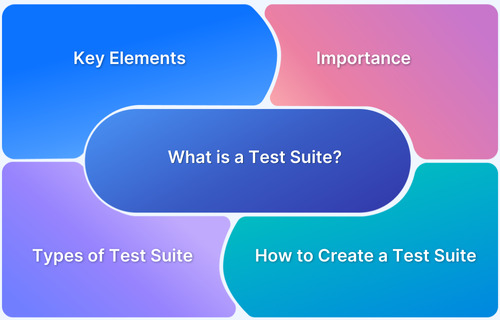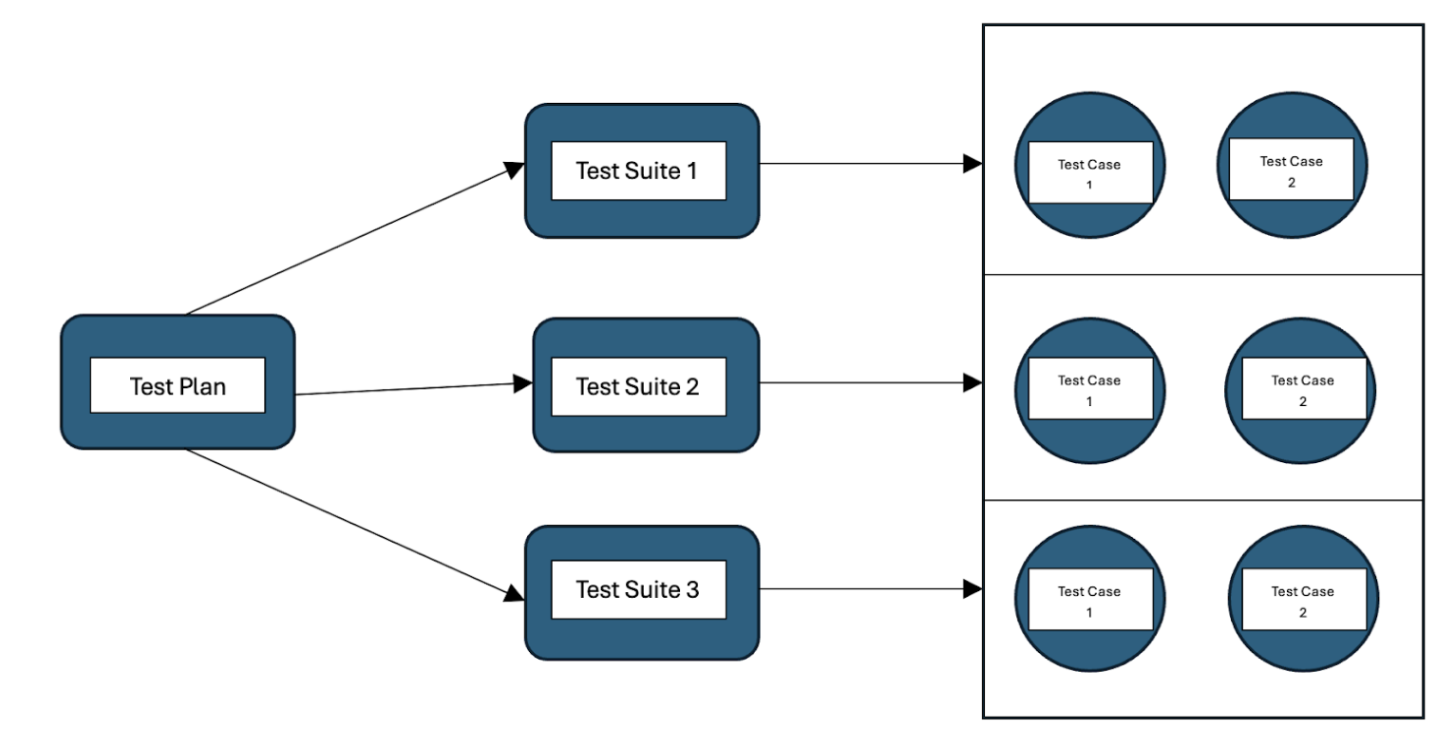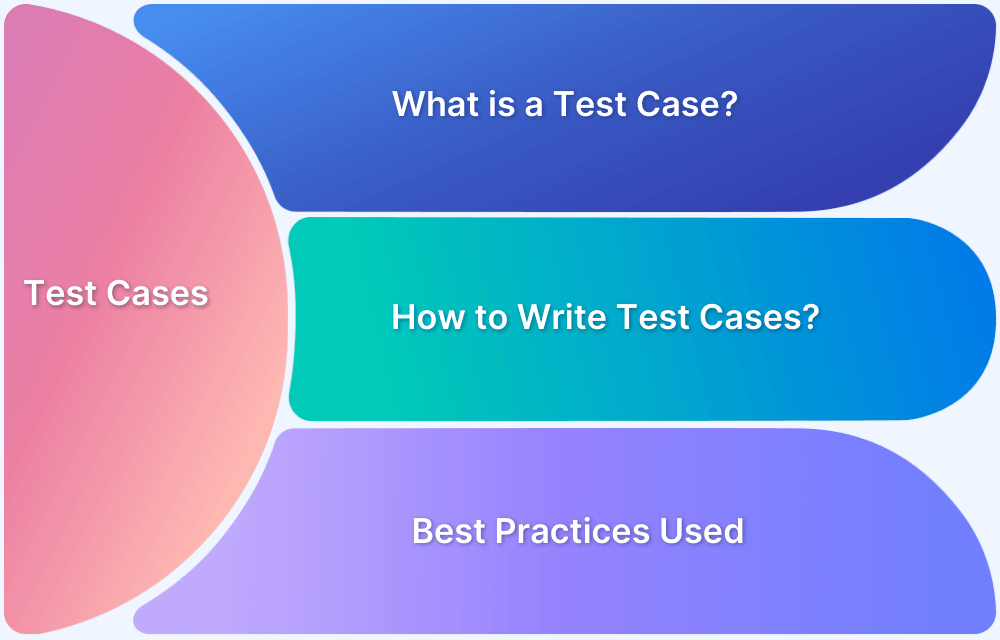Software applications are the backbone of modern businesses & their success hinges on reliability & flawless performance. To make sure these qualities are thoroughly tested, a test suite becomes an important component of the process.
Overview
What is a Test Suite?
A test suite is a collection of test cases designed to verify that a software application functions as expected. It covers features, integrations, and performance and is used in manual and automated testing to ensure thorough validation.
Key Elements of a Test Suite
- Test Cases: Define scenarios, inputs, steps, and expected outcomes to verify features.
- Test Scripts: Automated commands to execute test cases and handle repetitive tasks.
- Test Data: Inputs used to test scenarios and validate behavior under different conditions.
Types of Test Suites
- Functional Test Suite: Validates individual functionalities of the software against requirements.
- Regression Test Suite: Ensures existing functionalities remain unaffected after code changes.
- Smoke Test Suite: Conducts basic checks to verify system stability for further testing.
- Integration Test Suite: Tests module interactions to ensure seamless data flow and compatibility.
This article delves into the concept of a test suite, its key components, types, and best practices to ensure the delivery of high-quality software.
What is a Test Suite?
A test suite is a set of test cases to check if a software application works as expected. Each test case focuses on specific application parts, such as features, integrations, or performance. Test suites can be used in both manual and automated testing to ensure the software is thoroughly tested.
Example:
Take an e-commerce app with login, product search, and checkout features. A test suite for this app might include:
- Tests to check login (valid/invalid credentials, password reset).
- Tests for product search (keywords, filters, sorting).
- Tests for the checkout process (payment methods, cart updates, order confirmation).
Key Elements of a Test Suite
A well-structured test suite is essential for effective software testing, ensuring thorough validation of an application.
It primarily consists of:
- Test Cases: These define specific scenarios to test, including the input conditions, executing steps, and the expected outcomes for verifying a particular feature or functionality.
- Test Scripts: These are automated sequences of commands used to execute test cases. They are often written in programming or scripting languages and help automate repetitive testing tasks.
- Test Data: It is the set of inputs required during test execution. It is critical for testing various scenarios and edge cases to validate the application’s behavior under different conditions.
Must Read: Test Case Vs Test Script
Importance of a Software Test Suite
A test suite is important due to the following reasons:
- Improves Software Quality: By identifying bugs and issues early, a test suite helps deliver a reliable and high-quality product.
- Saves Time and Costs: Catching defects during development reduces the cost of fixing them later, saving time and resources.
- Ensures Consistency: Test suites provide a structured way to verify software behavior across different versions and environments repeatedly.
- Speeds Up Development: Automated test suites streamline testing, allowing developers to focus on new features instead of manually re-checking functionality.
- Builds Confidence: A well-maintained test suite gives developers and stakeholders confidence that changes won’t break the application.
- Supports Continuous Integration: Test suites are integral to CI/CD pipelines, ensuring that every code change is automatically validated before deployment.
- Improves Collaboration: By defining clear test cases, test suites promote better understanding & communication among the team.
Different Types of Test Suites
Following are the different types of test suites:
1. Functional Test Suite
A functional test suite is designed to verify the software’s specific functionalities. It ensures that each function operates according to the requirements and meets user expectations. These tests validate individual features by focusing on input, behavior, and expected outcomes.
Example:
- Verifying login functionality.
- Testing user registration and password reset features.
2. Regression Test Suite
Regression test suites focus on re-testing the software after code changes to ensure that existing functionalities remain unaffected. This type of testing is essential for maintaining software quality over multiple releases or updates.
Example:
Running a regression test suite after every deployment to confirm that previously implemented features still work correctly.
3. Smoke Test Suite
A smoke test suite is a collection of basic test cases that verify the application’s core functionality. It behaves as a preliminary check to determine whether the system is stable enough for more extensive testing.
Example:
- Verifying that the application launches successfully.
- Ensuring core features such as navigation or basic transactions are operational.
Also Read: What is Smoke Testing tool?
4. Integration Test Suite
Integration test suites evaluate the interactions between different software modules or components. They ensure that combined parts of the application work seamlessly and that data flows correctly across systems.
Example:
Testing the data flow between the front-end user interface and the back-end database.
Learn More: Top 15 Integration Testing Tools
How to Create a Software Test Suite
Below is a simple, step-by-step instructions to build a reliable test suite:
- Step 1: Define the purpose of the test suite, specifying aspects like functionality, performance, or integrations to align with project goals.
- Step 2: Choose test cases based on objectives, with detailed steps, input data, and expected results, ensuring they are independent, reusable, and maintainable.
- Step 3: Cluster related test cases for clarity and prioritize them by execution order, addressing dependencies and prerequisites.
- Step 4: Pick tools and frameworks that support your manual or automated tests and integrate well with your development environment.
- Step 5: Configure the test suite, write scripts if automating, and set up the test environment, ensuring the suite meets objectives.
- Step 6: Run the suite to identify issues, review results, and update it regularly to reflect application changes.
Steps to Execute a Test Suite
Here’s how you can effectively execute a test suite:
- Set up the Test Environment: Configure the test environment to imitate the production setup, including all necessary resources, test data, and dependencies.
- Plan the Execution Order: Arrange the test cases logically, prioritizing critical tests and considering dependencies to catch major issues early.
- Execute the Test Suite: Use automation tools to run the test suite or execute the test cases manually by following documented steps—record outcomes accurately during test execution.
- Monitor and Log Results: Track the execution process, noting the status of each test case. Log outcomes, error messages & other key details to identify issues.
- Analyze Failures: Review failed test cases to identify the root cause of defects or environmental issues impacting the tests.
- Report Results: Compile a test report summarizing outcomes, highlighting defects, and sharing key findings with stakeholders.
- Retest and Re-execute: After fixing identified bugs, rerun the relevant parts of the test suite to confirm the issues are resolved and ensure software quality.
Advantages of a Software Test Suite
Some of the advantages of a test suite are:
- Improved Test Coverage: Test suites ensure all application parts are tested by grouping similar test cases together, helping catch any potential issues.
- Efficiency in Regression Testing: Automated test suites quickly check if new code changes affect existing features, making regression testing faster and more reliable.
- Better Test Management: Test suites help organize and run tests systematically, making it easier to track progress, spot gaps, and maintain consistency across tests.
- Supports Continuous Integration: Test suites integrate with CI/CD pipelines, allowing tests to run automatically with every code change for quick feedback and faster problem resolution.
- Consistency: Predefined test cases ensure the tests are run the same way every time, reducing human error and providing consistent results.
- Cost Savings: Test suites help save time and money by catching bugs early and automating repetitive tests, reducing the need for costly fixes later.
Limitations of a Software Test Suite
Some limitations are mentioned below:
- High Initial Setup Costs: Building a comprehensive test suite, especially automated ones, can be time-consuming and expensive in terms of tools, frameworks, and resources.
- False Positives/Negatives: Test suites may produce inaccurate results by reporting issues where there are none (false positives) or by failing to detect real issues (false negatives).
- Requires Maintenance: Test suites need continuous updates to stay relevant as the software evolves. Otherwise, test cases can become outdated.
- Scalability: As applications grow, test suites can become large and complex, making them harder to maintain and execute efficiently.
- Flaky Tests: Flaky tests produce inconsistent results, making the test suite unreliable and difficult to trust.
- Resource Constraints: Limited resources can make it challenging to run large test suites, especially when there are tight deadlines or insufficient hardware/software for testing.
Also Read: How to find Flaky Selenium Test Suite
Test Case vs Test Suite: Core Differences
Here is are the core differences between Test Case and Test Suite:
| Aspect | Test Case | Test Suite |
|---|---|---|
| Definition | A single test that verifies a specific functionality or feature | A collection of test cases grouped together to test a broader functionality or module |
| Purpose | To validate a particular feature or behavior of the software | To organize and manage multiple test cases for comprehensive testing |
| Scope | Narrow focus, testing one specific aspect of the application | Broader scope, covering multiple related test cases to test a larger feature or module |
| Components | Includes steps, input data, expected result, and actual result | Composed of multiple test cases, along with their execution order and dependencies |
| Execution | Executed individually, focusing on a single scenario | Executed as a group, with multiple test cases being run together |
| Maintainance | Requires updates based on changes to specific functionality | Needs periodic updates to ensure that all included test cases remain relevant and cover new features |
| Example | Test case for verifying the login functionality | A test suite for validating the login, user registration, and password reset functionalities |
Streamline Test Management with BrowserStack
Managing test suites effectively is critical for ensuring software quality, and BrowserStack offers the ideal platform for this purpose.
Benefits of using BrowserStack Test Management:
- BrowserStack’s cloud-based infrastructure allows teams to execute and manage test suites across thousands of real browsers, devices, and operating systems. This removes the need for complex on-premise setups.
- Features like parallel testing enable teams to run multiple tests simultaneously, reducing testing time. Real-time debugging helps quickly identify and resolve issues, ensuring a smoother process.
- Whether running functional, regression, or integration test suites, BrowserStack ensures reliable and scalable solutions for all testing needs.
- By using BrowserStack, teams can elevate their test management process, streamline collaboration, and deliver high-quality applications more efficiently.
Best Practices to Create a Test Suite
The best practices to be followed to create a software test suite are listed below:
- Write Independent Test Cases: Ensure each test case is independent, meaning it can run independently without relying on the results of other tests.
- Keep Test Cases Simple and Focused: Each test case should focus on a single feature or functionality. Simplicity helps identify and fix issues easily.
- Use Reusable Test Data: Create test data that can be reused across multiple test cases. This helps maintain consistency and reduces the effort required for test preparation.
- Prioritize Critical Tests: Identify the most important functionalities and prioritize testing them first.
- Automate Where Possible: Automate repetitive or time-consuming test cases, especially regression tests, to save time and improve efficiency.
- Maintain Test Suites Regularly: As the software evolves, update and refactor your test suite to reflect changes for continued effectiveness.
- Use Version Control: Store your test cases and related resources in a version control system to make it easier to track changes.
- Ensure Clear Documentation: Document each test case with detailed steps, expected results & any relevant information.
Conclusion
A well-designed test suite is essential for ensuring the quality and functionality of software applications. It helps identify issues early, making sure the application meets user expectations and performs smoothly.
By understanding the key components and applying best practices, teams can create effective test suites, contributing to the overall success of software development projects.






